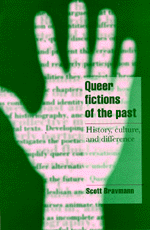

![]()
![]()

But then, starting somewhere around the publication of Mary McIntosh's Homosexual Role in 1967, this idea of homosexual history started to dramatically shift. No longer was the homosexual or lesbian a person who strode through the pages of history unchanged: instead, in the words of the most long lasting debate in lesbian and gay studies in the 1970's and 1980's, we were - 'socially constructed'. At its simplest, all this meant was that same sex desires were organised in different ways - politically , economically, religiously, familially- in different times and places. There was no unitary essence for there to be 'a history of....'. Instead, there were multiple pathways, experiences and identities fashioned and shaped by particular sets of historical experiences. And it started to produce a remarkable set of books and studies :Duberman, Vicinus, Foucault, Weeks, D'Emilio, Faderman, Halperin, Katz, Freedman, Ruggierio and Chauncer come immediately to mind. History, now, had become more complex.
But now comes Scott Bravmann's book to queer the pitch, to make the histories we tell seemingly even more complex. His task in this short but dense book is to show how even these constructionist studies worked from some latent modernist notion of the gay or lesbian which obscures many 'differences' (especially of gender and race). He wants to see the idea of 'the making of the modern homosexual' as a narrative rather than a fact. He champions the ideas around the newly transgressive queer. He seeks to demonstrate the use of historical language in the construction of gay lives - to reveal how 'history'is used; and he aims to set into dialogue these historical speeches of the past to guide and debate the present. In all this, he draws from the spaces created by postmodernism, the new narrative histories of Hayden White, the work of popular memory groups, and of course from the queer theorists. History now goes queer, and Queer is seen as partially deconstructing our own discourses and creating a greater openness in the way we think through our categories. It is, to quote Michael Warner, a stark attack on 'normal business in the academy' (p. 25).
The core of the book might be seen as four chapters which show the narratives of history at work First, Bravmann critiques the 'modernist narrative logic of social constructions historical accounts of gay identity formation' through four highly regarded recent (but U.S.) 'constructionist' studies : those of George Chauncey, Lillian Faderman, Elizabeth Kennedy and Madeline Davis, and Esther Newton. Then he looks at the ways in which two key themes - the 'Greeks' and 'Stonewall' - come to 'monumentalise' certain moments of gay history. In the latter Martin Duberman's now classic account becomes the prime object of critique; in the former some of the ideas of Symonds, Bronski and Judy Grahns are scrutinsed. And then in a brilliant chapter he turns to a discussion of who is and who is not included in writing these histories, a route that takes Bravmann to a discussion of writing strategies and hybrid texts. The focus here is on work with difficult links to various people of colour in North America, with compelling accounts of the intrusions of the like of Audre Lorde, Samuel Delany, Pratibha Parmar, and Isaac Julien both into gay consciousness and back into their own 'ethnic/racialised' diasporas. How did men of colour get there in the images but not in the written histories? Who is the Berdache in Native American texts, so widely cited as gay in gay texts? How did colour and race get written out and written in?
Yet, despite this book's awareness of hybridity etc, like most similar US products it stays firmly with the limits of North American (and to a lesser extent, British) society. It is still as if the core remains the hegemonic USA, and the histories of the past flow from it. Africa, Latin America, the Pacific Rim are scarcely mentioned in a book that claims to traverse the limited white constructions of the recent past. All the work of recent Latin American scholars for example is expunged- continuing to create a peculiarly North American field in an argument where surely this has to be explicitly avowed. It also reveals something of the difficulties, limits and maybe impossibility of the project that is being set, since the incoproration of more and more 'standpoints' and narratives is rendered a very a daunting task.
The book has a title riddled with irony as it tries to tell the reader what it will do. It is not about lesbians and gays, but 'queers' - though it oddly misses out age, transgender, bisexualities, paedophilia and the rest to highlight the chosen issues of race and gender, and it does this almost wholly from a US - not a global or post colonial - base. It is not about truth but about 'fictions' - though it oddly misses out any discussion of epistemological matters and the dangers of such a language in promoting a kind of excessive relativity. It is not about the past but about the present, about the ways in which new narratives are appearing to locate queer pasts, gay pasts, and homosexual pasts to guide lives into the future.
In the spate of new books on lesbian/gay/queer studies - many of which are not worth reading - this short book has something to say, and says it focusedly, forcefully and in an intellectually compelling way. Yet finally, I am not convinced that the general argument is really all that new. As one of those who has written about The Making of the Modern Homosexual twenty odd years ago, I find little in this book to disagree with. It seems to me to be just the next logical stage in the argument, and one that now is being broadened out to the wider globalising world.
Ken Plummer
University of Essex